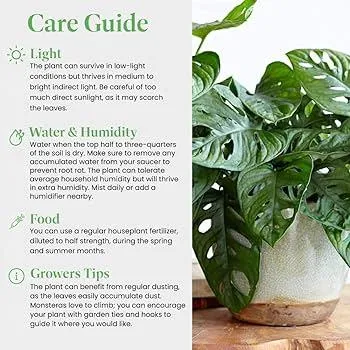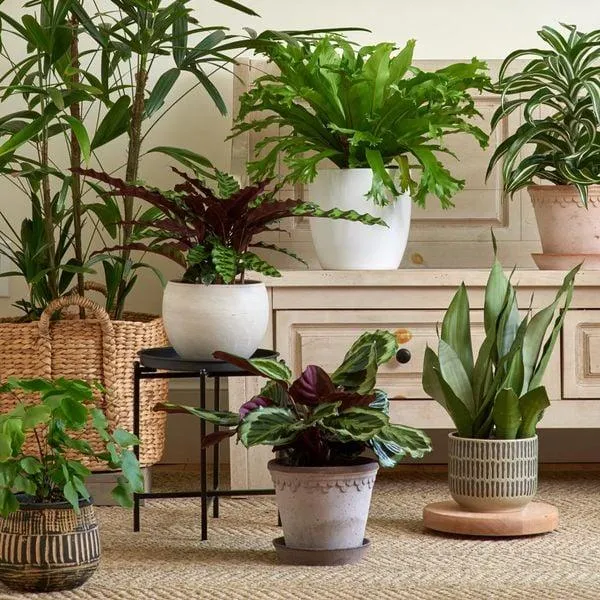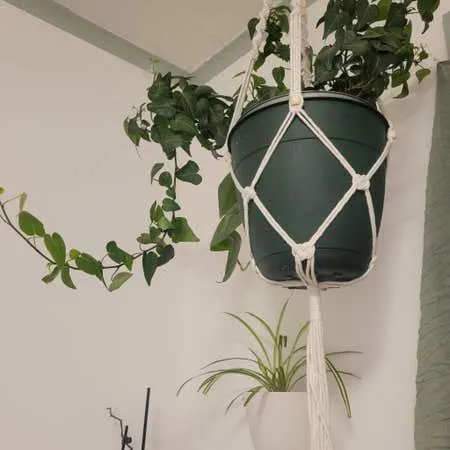The Complete Guide to Caring for Ivy Plants Indoors
If you’re looking for a low-maintenance houseplant that adds flair to your home, ivy plants might be right up your alley. Known for their beautiful glossy leaves and ability to climb surfaces, ivies make great additions to indoor spaces. But caring for them properly takes some know-how.
In this article, I’ll cover everything you need to know to keep your ivy plant thriving indoors, from watering and lighting needs to trimming and propagating tips. By the end, you’ll be an ivy plant pro!
Choosing an Ivy Variety
First things first – you’ll want to pick out the right ivy for your space. Some popular types for indoor growing include:
- English ivy – A versatile climber with small leaves. Easy to care for.
- Swedish ivy – Heart-shaped leaves that come in green or variegated varieties. A classic choice.
- Needlepoint ivy – Tiny scalloped leaves. Great for trails or hanging baskets.
- Creeping fig – Nearly leafless stems that resemble twigs. A unique texture.
Take inventory of light levels, decorative needs, and available surfaces before settling on a variety. With some ivies, you can practically grow them anywhere – even out of teacups or boots! But English ivy seems to suit most people’s homes.
Water and Humidity
Ivies like moderate moisture levels, so water when the top inch of soil is dry. Overwatering can cause root rot, so don’t get crazy with the H20. Use lukewarm water, never cold, which can shock the plant. Misting the leaves is also beneficial to increase humidity around 50-60%.
From my experience, ivies tend to dry out faster in low humidity environments like heated homes in winter. Place the pot on a pebble tray filled with water to boost surrounding air moisture. Or invest in a humidifier, especially if growing multiple plants.
Lighting Needs
Most ivy varieties thrive in bright, indirect sunlight. Direct sun can scorch delicate leaves. South- or east-facing windows provide perfect illumination. I’ve found grouping plants together helps simulate their naturalhabitat under a forest canopy.
Keep in mind lighting requirements may vary slightly by variety. Swedish ivy demands slightly lower light, while English ivy tolerates medium light. Experiment with different spots to find your plant’s happy place. Too much shade can lead to leggy growth.

Soil and Fertilizer
Ivy plant soil should be well-draining potting mix suitable for indoor plants. Check the label to ensure it contains nutrients to sustain growth. Replenish soil every 2-3 years for optimum health.
Use a diluted liquid houseplant fertilizer monthly in spring and summer. I like to mix 1/4 strength into the watering can. Too much fertilizer can burn delicate roots. Slow release granules are fine too and basically hands-off.
Pruning and Training
Take the time to train climbing ivies up poles, trellises, or other supports. Use twine or garden ties to attach new growth in the desired direction. Pruning keeps plants bushy and encourages branching.
Trim off leggy stems or sections not receiving enough light with pruning shears. Sanitize blades between cuts. You can propagate trimmings by sticking leafless stem cuttings into soil. Kind of cool to grow “copies” of your plant!
Pests and Problems
Ivies aren’t usually prone to many issues indoors. But occasionally pests like spider mites, scale, or mealybugs may feed on foliage. Inspect leaves regularly for signs of infestation like white spots or webbing.
Spider mites especially love dry indoor environments. Up your game on humidity control. Rinse plants with a strong water stream to physically remove pests or spot treat with insecticidal soap.
Leaf yellowing or dropping may indicate overwatering, underwatering, or not enough light. Diagnose causes and make adjustments like moving the plant. A location change is sometimes all that’s needed to perk things up.
Propagation
Many types freely self-propagate by rooting where stems touch soil or other surfaces. Propagation lets you spread ivy plant love to other areas. Simply remove a rooted piece and repot for a new plant bish, bash, bosh!

You can also take stem cuttings as mentioned before. Stick cut ends 1-2 inches deep in potting mix under humidity domes or plastic bags to retain moisture until roots emerge – usually a few weeks. Water lightly and check for roots often.
Leaf cuttings also root, though success varies. Lay leaves vein-side down and mist frequently. New plant growth forms at the stem junction. Kind of wild if you get it working! Takes patience but fun to try different propagation methods.
Common Problems and Solutions
Here are a few issues house ivy plants often face and how to remedy them:
Yellowing leaves:
Overwatering is usually the culprit. Improve drainage and allow soil to dry out more between waterings.
Brittle leaves:
The plant needs more humidity. Mist regularly or use a pebble tray or humidifier.
Leggy growth:
Prune stems back to encourage bushier growth. Make sure it’s getting enough light.
Leaf drop:
Underwatering, pests, or insufficient light could cause shedding. Check soil moisture and troubleshoot other potential stressors.
Sparse foliage:
Cut off all bare stems and repot in fresh soil and fertilizer. Ivy may be past saving if severely affected.

Final Thoughts
With basic care like watering, nutrients, pruning, and pests control, ivy plants make low-effort indoor foliage. They thrive on neglect to some degree – basically indestructible! Their versatility as vines, groundcovers, or hanging specimens make ivies a charming accent in homes.
Let me know if you have any other ivy growing questions! With diligent TLC these plants can live for years indoors, bringing nature’s beauty inside. So go pick out your perfect ivy and get growing – you’ll be proud of all their amazing growth. Enjoy your new trailing buddy!
Ivy Plant Indoor Care Essentials
| Light Needs | Ivy prefers bright, indirect sunlight. It will tolerate low light but may grow more slowly. Keep it near an east or west facing window. |
|---|---|
| Water Needs | Water when the top inch of soil is dry. Water thoroughly until draining out bottom holes. Let soil dry slightly between waterings. |
| Humidity | Ivy appreciates moderate humidity around 50%. Use a pebble tray or humidifier if air is very dry. |
| Temperature | Keep away from drafts near windows and vents. Normal household temperatures between 60-80°F are suitable. |
| Fertilizer | Feed monthly in spring and summer with a balanced houseplant fertilizer diluted to 1/2 the strength on label instructions. |
FAQ
-
How often should I water my ivy plant?
Ivy needs moderately moist soil. Basically water when the top inch of soil gets kind of dry. Check the soil by sticking your finger in it. Water thoroughly until water comes out the drainage holes, then let the excess water drain out. Allow the soil to partly dry between waterings.
-
What light conditions does ivy prefer?
Ivy can tolerate low light, but it will grow best with bright, indirect sunlight a few hours each day. However, too much direct sun may scorch the leaves, especially if the plant is not used to it. The location should provide adequate sunshine while filtering the sun’s rays. East or west facing windows generally work well.
-
How should I fertilize my ivy?
Feed ivy with a water soluble houseplant fertilizer once a month during the growing season from spring to fall. Dilute fertilizer as directed and water thoroughly after application. You can basically skip feeding in winter when growth slows. Make sure the pot has drainage holes to prevent fertilizer build up in the soil.
-
How do I prune an overgrown ivy?
Occasionally, older ivy vines may get unwieldy or leggy. You can trim them back to maintain a nice full shape. Cut stems back to the nearest leaf set or node. Sharp pruning shears work well. Removing about a third of the long stems at a time will encourage branching and keep the plant bushy. Be sure to disinfect shears between cuts to prevent spreading disease.
-
How can I make my ivy vine?
To encourage vining, provide a support for the ivy to climb. You can use a moss pole, twist ties on a wire frame, or tie vines to a picture frame. The vines will basically attach themselves with tiny adventitious roots. Check that the support is securely fastened so it doesn’t topple over under the weight of the enthusiastic climber. You may need to initially guide vines in the desired direction with twist ties.
-
My ivy’s leaves are yellowing, what’s wrong?
Yellow leaves can indicate over- or underwatering. Make sure the soil isn’t staying too soggy or dry for too long. Check the drainage holes aren’t plugged. Transplant shock or nutrient deficiency can also cause yellowing. Examine for pests like spider mites which may be sucking sap from the leaves. As a last resort, pruning back yellow foliage may help stimulate new growth.

Hopefully this helps address some common questions about caring for your ivy plant indoors! Let me know if you have any other issues. I found growing plants to be an relaxing way to spend time at home, or so it seems from the research. You just gotta pay attention to their needs and watch them thrive. It’s basically free therapy right in your home, if I do say so myself!
